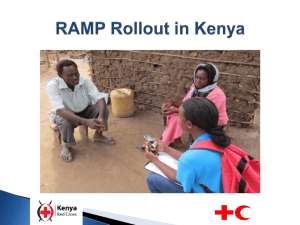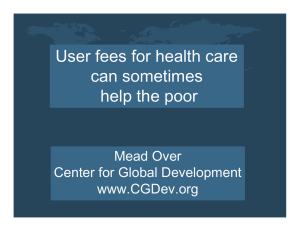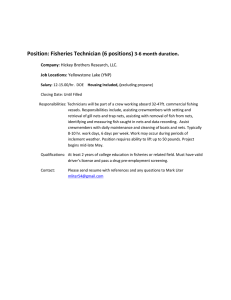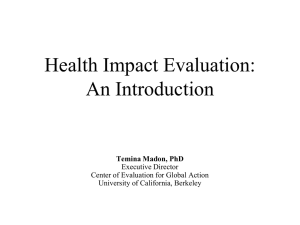Journal of Applied Medical Sciences, vol. 3, no. 1, 2014,... ISSN: 2241-2328 (print version), 2241-2336 (online)
advertisement
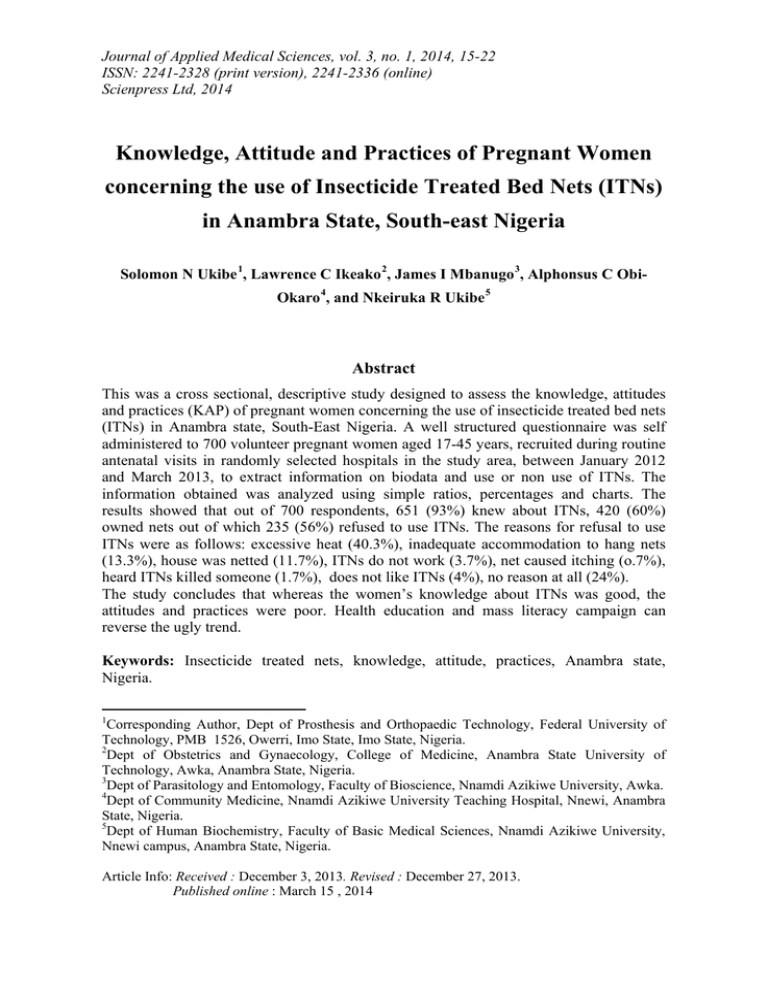
Journal of Applied Medical Sciences, vol. 3, no. 1, 2014, 15-22 ISSN: 2241-2328 (print version), 2241-2336 (online) Scienpress Ltd, 2014 Knowledge, Attitude and Practices of Pregnant Women concerning the use of Insecticide Treated Bed Nets (ITNs) in Anambra State, South-east Nigeria Solomon N Ukibe 1, Lawrence C Ikeako 2, James I Mbanugo 3, Alphonsus C ObiOkaro 4, and Nkeiruka R Ukibe 5 Abstract This was a cross sectional, descriptive study designed to assess the knowledge, attitudes and practices (KAP) of pregnant women concerning the use of insecticide treated bed nets (ITNs) in Anambra state, South-East Nigeria. A well structured questionnaire was self administered to 700 volunteer pregnant women aged 17-45 years, recruited during routine antenatal visits in randomly selected hospitals in the study area, between January 2012 and March 2013, to extract information on biodata and use or non use of ITNs. The information obtained was analyzed using simple ratios, percentages and charts. The results showed that out of 700 respondents, 651 (93%) knew about ITNs, 420 (60%) owned nets out of which 235 (56%) refused to use ITNs. The reasons for refusal to use ITNs were as follows: excessive heat (40.3%), inadequate accommodation to hang nets (13.3%), house was netted (11.7%), ITNs do not work (3.7%), net caused itching (o.7%), heard ITNs killed someone (1.7%), does not like ITNs (4%), no reason at all (24%). The study concludes that whereas the women’s knowledge about ITNs was good, the attitudes and practices were poor. Health education and mass literacy campaign can reverse the ugly trend. Keywords: Insecticide treated nets, knowledge, attitude, practices, Anambra state, Nigeria. 1 Corresponding Author, Dept of Prosthesis and Orthopaedic Technology, Federal University of Technology, PMB 1526, Owerri, Imo State, Imo State, Nigeria. 2 Dept of Obstetrics and Gynaecology, College of Medicine, Anambra State University of Technology, Awka, Anambra State, Nigeria. 3 Dept of Parasitology and Entomology, Faculty of Bioscience, Nnamdi Azikiwe University, Awka. 4 Dept of Community Medicine, Nnamdi Azikiwe University Teaching Hospital, Nnewi, Anambra State, Nigeria. 5 Dept of Human Biochemistry, Faculty of Basic Medical Sciences, Nnamdi Azikiwe University, Nnewi campus, Anambra State, Nigeria. Article Info: Received : December 3, 2013. Revised : December 27, 2013. Published online : March 15 , 2014 16 Solomon N Ukibe et al. 1 Introduction Malaria is unarguably the most important disease of mankind and has remained a thorn in the flesh in Sub- Saharan Africa especially in pregnant women and children [1, 2] where the disease has taken its tolls. Different methods have been designed to control the scourge of malaria among which includes the use of Insecticide treated bed nets (ITNs) which were introduced in Nigeria in the year 2000 following a meeting of the African Heads of States in Abuja, the capital city of Nigeria [3]. Despite reports [4 ,5] of reduced incidence of malaria in pregnancy and hence the incidence of pregnancy related complications, studies in Nigeria and other third world countries [6-12] have shown that the use of ITNs in pregnancy has remained poor in spite of the increased health education and awareness campaign mounted by government agencies. Consequently, the prevalence of malaria in pregnancy has been reported to be high over the years [13, 14] with its attendant complications. In our previous study [15], we had reported high awareness level (93%) of pregnant women concerning the use of ITNs in pregnancy, relatively high ownership level (60%), but poor use of ITNs (46%) in pregnancy. It is evident from this report that the ownership of ITNs does not translate into actual use. The present study was therefore designed to assess the knowledge, attitudes, and practices of pregnant women which might hamper or promote the use of ITNs in pregnancy in Anambra State, South –eastern Nigeria. 2 Materials and Methods 2.1 Study Area Five different hospitals located in three major cities in Anambra state namely Awka, Onitsha, and Nnewi were chosen for the study. These hospitals include: 1. General Hospital/Anambra State University Teaching Hospital, Awka: This is the biggest state owned tertiary health institution located in the heart of the state capital Awka with an estimated population of about 300,000 people [16]. 2. Divine Hospital and Maternity, Awka: This is one of the busiest privately owned health institutions in the state patronized by a lot of pregnant women in the state capital and its environs. 3. Christ the King Hospital and Maternity, Awka: Like the above named hospital, this is a specialized health institution that caters for a large population of pregnant women in the state capital and its environs. 4. General Hospital Onitsha: Is the second largest state owned secondary care health institution catering for an estimated population of more than 300, 000 people [16] 5. Life Specialist Hospital Nnewi: Is a specialist centre located in the centre of Nnewi, the third largest commercial city of the state. It is owned and managed by a Professor of reproductive health. Anambra State is located in the South Eastern part of Nigeria with a population of 4.9 million [16]. The state is bounded to the east by Enugu state, to the West by Delta state, to the North by Kogi state and to the South by Imo state. Insecticide Treated Bed Nets (ITNs) in Anambra State, South-east Nigeria 17 2.2 Study Population 700 volunteer pregnant women aged 17-45 years were recruited for the study between January 2012 and March 2013. The age range represents the reproductive age. To arrive at the sample size, the annual 3% growth rate for the female population in Nigeria was determined as at 2004. The population of women of reproductive age which is 49% of all female population was determined. Pregnant women constitute 5% of women of reproductive age and this was also determined. The figures obtained were substituted in the formula for calculation of sample size. Informed consent was obtained from them and due permission was sought for and obtained from the Heads of the different hospitals used for the study. 2.3 Questionnaire Administration A structured questionnaire was self administered to the women to obtain information on biodata, awareness, ownership and reasons for non use of ITNs during pregnancy among other information. The questionnaire was composed of five sections A-E with section C dwelling on use of ITNs. 2.4 Statistical Analysis The version 16 of SPSS was used for statistical analysis. Analysis of variance (ANOVA) was used and simple graphs and charts were used for data representation. 3 Results 7% Aware not aware 93% Figure 1: Awareness of ITN use among pregnant women in Anambra State, Aware: 93%, Not aware: 7% 18 Solomon N Ukibe et al. Total No. with ITN 40% 60% Total No. without ITN Figure 2: Ownership of ITN among pregnant women in Anambra State, Nigeria, Total No. with ITN: 60%, Total No. without ITN 40% 23% Always Sometimes 56% 21% Never Figure 3: Rate of use of ITN among pregnant women in Anambra State, Nigeria, Always: 23%, Sometimes: 21% and Never: 56% Insecticide Treated Bed Nets (ITNs) in Anambra State, South-east Nigeria 19 No reason Ineffective ITN kills Itching H/netted Unsuit Acc Dislike ITN Heat 0.00% 10.00% 20.00% 30.00% 40.00% 50.00% Figure 4: Reasons for non use of ITN by pregnant women attending antenatal clinic in Anambra State, Heat: 40.30%, Dislike ITN: 4%, UnsuitAcc: 13.30%, H/netted: 11.70%, Itching: 0.70%, ITN kilss: 1.70%, Ineffective: 3.70%, No reason; 24% Key: Unsuit Acc = unsuitable accommodation H/netted = house netted Despite the high awareness level (93%, Fig1) and ownership level of 60%,(Fig 2) 392 pregnant women (56%,Fig 3) failed to use ITNs for reasons varying from excessive heat (40.30%), unsuitable accommodation to hang the nets (13.30%), residential accommodation already netted (11.70%), and simply dislikeness of ITNs. Some of the women (3.7%) believed ITNs were not effective. Few of the women (1.70%) believed ITNs killed someone due to some dangerous chemicals used to treat them while very few (0.70%) claimed it caused itching. A reasonable number of the women (24%) had no specific reason while they refused to use the nets (Fig 4). 4 Discussion The present study showed that despite the high awareness level of pregnant women concerning the use of ITNs and the relatively high level of ownership which has increased over the years in malaria endemic countries [17-20], majority of the respondents refused to use the nets for one reason or the other. Most of the women interviewed (40.3%) refused to use ITNs because it caused excessive heat and made sleeping uncomfortable. Reports from previous studies in malaria endemic areas [21-24] collaborate this finding. Excessive heat from poor ventilation is indeed a serious barrier agaist peoples utilization of ITNs even when these nets are distributed free of charge by governments. In Nigeria generally and Anambra state in particular, this is a genuine reason for people to refuse the use of ITNs in preference to the nuisance and disease caused by mosquitoes considering the tropical nature of the climate and the attendant temperature generated especially during the dry seasons. This matter is made worse by lack of or inadequate supply of 20 Solomon N Ukibe et al. electricity which makes it impossible for residents to use their fans or air conditioners for those who can afford them. Moreover residential accommodations are often inadequate thereby promoting overcrowding with its attendant problems hence a significant proportion of the respondents failed to use the nets as a result of unsuitable accommodations to hang the nets. This barrier can be surmounted through housing policies that could enable most of the inhabitants to own and live in descent and affordable houses. Accommodation will become a much serious issue when people living in rural communities are considered in view of the fact that the current study was urbanbased. Some of the respondents in this study reported itching or skin irritation as the major deterrent that made them to stop using ITNs. A similar report has been documented by Zangpo et al,[25]. Itching from the use of ITNs could result from the chemical components or as a manifestation of hypersensitivity reaction from the physical component of the nets which serves as a foreign body. This particular problem calls for more investigations. Some of the respondents failed to use ITNs simply because they “heard” ITNs killed someone or they “do not work”. This notion suggests high degree of misconception and misinformation. This reason for non use of ITNs was popular among women with poor educational background and is a very important barrier militating against the use of ITNs in this part of the world. However, in the present study only a small fraction (0.085%) of the respondents had no formal education possibly because the study was urban-based. In rural communities with higher level of illiteracy, the problem of misconception and poor perception will be made worse by cultural beliefs and practices. For instance, in a particular study in villages along Lake Victoria [26], mosquito nets were used by the indigenes for fishing instead of protection against malaria. What an irony! Poor perception about the use of ITNs can be addressed through mass literacy campaigns and aggressive health education. A reasonable percentage of the respondents (24%) had no specific reason why they refused to use ITNs despite the ownership. Some simply said they “did not like ITNs”. This is another case of misconception and poor attitudes which could be fuelled by illiteracy and ignorance. A study in Nairobi [27] has reported significant association between level of education and adequate knowledge about the use of ITNs in pregnant women. The relatively low level of acquisition of nets observed in the present study was attributed to unavailability and cost. In sub- Saharan Africa, the poverty level is such that most people can not afford a three square meal a day. In this circumstance, it becomes a luxury for one to purchase a mosquito net from the open market. Even when these nets are given to people free of charge, some of them sell the nets to generate income to solve other pressing needs. However, free distributions of nets by governments have been reported [28, 29] to encourage use by pregnant women despite the barriers highlighted above. 5 Conclusion The present study concludes that whereas the knowledge of pregnant women concerning ITNs use was good, the attitudes and practices were poor. Provision of mass education, health education campaigns as well as basic social amenities such as housing and Insecticide Treated Bed Nets (ITNs) in Anambra State, South-east Nigeria 21 electricity will go along way to ameliorate this ugly situation. This will improve the use of ITNs in pregnancy and help to win the war against malaria. ACKNOWLEDGEMENTS: The authors are grateful to the management and staffs of the various hospitals who granted us access to their facilities especially Prof Joseph Ikechebelu of Life Specialist Hospital, Nnewi, Nigeria. References [1] [2] [3] [4] [5] [6] [7] [8] [9] [10] [11] [12] [13] Richard WS, Bernard L, Nah L, Mornica E, Parise Clara M; The burden of Malaria in pregnancy in Malaria endemic areas. Am J Trop Med Hyg 64(12)S: 28-35. Okwa OO.Preliminary investigations on malaria in sickle cell patients among pregnant women and infants in Lagos, Nigeria. Niger J Parasitol 2004; 25:81-85. Roll Back Malaria (RBM) 2001-2010. Malaria in pregnancy. Gamble CL, Ekwaru JP, Ter Kuile FO. Insecticide treated nets for preventing malaria in pregnancy. Coch data base of systemic reviews 2006; Acessed: Http://www.cochraine.org/reviews/en. Adeyemi AS, Adekande DA, Akinola SE.Use and prevalence of Insecticide treated mosquito bed nets among pregnant population in Osogbo, Nigeria. Nig Med Pract 2007;52(2):29-32. Isah AY, Nwobodo EI.Awareness and utilization of insecticide treated mosquito nets among pregnant mothers at a tertiary health institution in North Western Nigeria. Niger J Med 2009; 18(2):175-178 Salaudeen GA, Jimoh RO. Awareness and use of insecticide treated nets among women attending antenatal in a Northern state of Nigeria. J Pak Med Asso 2009; Acessed: http://www.jpma.org.pk Musa OI, Salaudeen GA, Jimoh RO. Awareness and use of insecticide treated nets among women attending antenatal clinics in a Northern state of Nigeria. J Pak Med Asso 2009; 59(6):354-358 Iwuh RU, Ijomah BC, Egeruo AS, Awurum IN, Ohalete CN. Awareness and use of insecticide treated nets among pregnant women attending antenatal clinic at Federal Medical centre and general hospital Owerri, Imo state, Report and Opinion 2010; 2(12):154-157. Oche MO, Ameh IG, Umah AS, Gana G, Njoku CH. Awareness and use of insecticide treated nets among pregnant women attending antenatal at Usman Dan Folio University Teaching Hospital Sokoto. Niger J Parasitol 2011; ISSN:11174145 Aluko JO, Oluwatosin AO. Utilization of insecticxide treated nets during pregnancy among postpartum women in Ibadan, Nigeria: a cross sectional study. BMC Pregnancy and child birth 2012;12-21 Runsewe-Abiodun TI, Inyanwura AC, Sotimehin SA, Awareness and knowledge about insecticide treated nets amongs pregnant mothers in Ogun state, Western Nigeria. A descriptive cross sectional study. Educ Res J 2012;2(5):138-145 Mbanugo JI, Okorudo O. Prevalence of Plasmodium infection in pregnant women in Aguata, Anambra state, South eastern Nigeria. J Environ Health 2005;2(2):64-68. 22 Solomon N Ukibe et al. [14] Aribodor DN, NwaOrgu OC, Eneanya CI, Aribodor OB. Malaria among primigravid women attending antenatal clinics in Awka, Anambra state, South Eastern Nigeria. Niger J Parasitol 2007; 28(1):25-27 [15] Ukibe SN, Mbanugo JI, Ukibe NR, Ikeako LC. Level of Awareness and useof insecticide treated bed nets among pregnant women attending antenatal clinics in Anambra state, South Eastern Nigeria. J Pub Health Epidemiol 2013; 5(9):391-396 [16] National Population Commission (NPC), Nigeria 2006 [17] Gersti S, Dunkley S, Muktar A, Maes P, De Smeth M, Baker S, Makere J. Long lasting insecticide treated net usage in eastern Sierra leone- the success of free distribution. Trop Med Int Health 2010;15: 480-488 [18] Hanson K, Marchant T, Nathan R, Mponda H, Jones C, Bruce J, Mshinda H, Shellenberg JA, Household ownership and use of insecticide treated nets among target groups after implementation of a national voucher programme in the United Republic of Tanzania: plausibility study using three annual cross sectional surveys, BMJ 2009, 339:B2434 [19] Baume CA, Marin MC. Gains in awareness, ownership and use of insecticide treated net in Nigeria, Senegal, Uganda and Zambia. Mal J 2008, 7:158 [20] Nor AM, Amin AA, Akhwale WS, Snow RW: Increasing coverage and decreasing in equity in insecticide treated net use among Rural Kenyan children. PLoS Med 2007, 4:e255 [21] Baume CA, Marin MC. Intra-household mosquito use in Ethiopia, Mali, Nigeria, Senegal, and Zambia: are nets being used? Who in the house uses them? Am J Trop Med Hyg 2007; 77:963-971. [22] Githinji S, Herbst S, Kistemann T, Noor AM. Mosquito nets in a rural area of Kenya: ownership, use and quality; Malar J 2010; 9:250. [23] Alaii JA, Hawley WA, Kolczak MS, ter Kuile FO, Gimnig JE, Vulule JM, Odhacha A, Oloo AJ, Nahlen bl, Phillips-Haward PA. Factors affecting use of permethrintreated bed nets during a randomized controlled trial in Western Kenya. Am J Trop Med Hyg 2003; 68:137-141.98 [24] Hlongwana KW, Mabaso ML, Kunene S, Govender D, Maharaj R, Knowledge, attitudes and practices (KAP) on malaria in Swaziland: a country earmarked for malaria elimination.Malar J 2009; 8:29. [25] Zangypo K, Zangypo N, Poulsen K. A study on knowlrdge, attitude and practice about malaria awareness and bed net use. J Bhutan Studies 2011; 135-146. [26] Minakawa N, Dida GO, Sonye GO, Futami K, Kaneko S. Unforeseen misuses of bed nets in fishing villages along Lake Victoria. Malar J 2008; 7:165 [27] Njoroge FK, Kimani VN, Ongore D, Akwale WS. Use of insecticide treated bed nets among pregnant women in Kilifi District, Kenya.East Afr Med J 2009; 86(7):314-22. [28] Pettifor A, Taylor E, Nku D, Duvall S, Tabala M, Mwandagalirwa K, Meshnick S, Behets F. Free distribution of insecticide treated bed nets to pregnant women in Kinshasa: an effective way to achieve 80% use by women and their new borns. Trop Med Int Health 2009;14:20-28 [29] Guyat H, Ochola S. Use of bed nets given free to pregnant women in Kenya. Lancet 2003; 362:1549- 1550.

